Pond maintenanceHas your pond or water feature gone to pot? Then read our complete guide to cleaning and maintenance. Over the past few years the popularity of garden landscaping and design has encouraged many of us to install water features in our gardens. They look fabulous initially, but over time they can turn into slimy, mosquito-infested bogs. Green water algae (or pea soup algae as it's also called), together with slime algae and blanketweed, are some of the many frustrations of pond and water feature owners. Algae are like the aquatic version of garden weeds, if you like. And like other weeds, they need light and nutrients to survive. If the surface of the water is constantly exposed to sunlight, algae will thrive. And if there's an abundance of nutrients in the water and not enough plants to compete for those nutrients, algae will be thanking you for that as well. Solutions:
The blanketweed algae is a lot more persistent and difficult to control. It's a filamentous algae that looks like green cottonwool and its spores are spread via the wind. Blanketweed is a particular problem with concrete water features and water features that have river boulders in them, because it likes a high pH, and those things create a high pH. Solutions:
MOSQUITOES By the way, mosquitoes hate moving water, so if you keep the water moving (with a fountain or waterfall), you won't have a problem. What they do like is shallow, stagnant water. So the steeper the pond's sides, the less sheltered area available for mosquito larvae to live. The egg-laying females will seek out the sheltered spots — even in the top of planter pots that are half submerged in water, or the shallow water in between rocks. Both these places provide an area for mosquito larvae to escape from fish. If you don't have moving water, here's a clever trick to discourage mosquitoes — add a few tablespoons of vegetable oil to the water. Mosquito larvae breathe through air tubes that link to the water's surface; the oil prevents them from obtaining oxygen by forming a barrier at the surface. But a word of caution, if you have fish, do not use this method — you shouldn't need to, anyway. The oil will inhibit gas exchange (that's the giving off of CO2 and the taking in of oxygen) at the surface and as a result suffocate the fish. FISH FROZEN WATER FEATURES Fish can handle the cold weather no problem. They'll just go to the bottom of the pond and remain inactive until the weather warms up. If you're down south and your pond freezes over, simply cut a hole in the ice to allow for gas exchange. Never smash it with a hammer or the shockwaves may kill your fish. One word of advice — for those of you in the deep south who use a UV clarifier for the control of green water algae, dismantle it and bring it inside for the winter. If the water that's inside them freezes, it can rupture the glass sleeve that's inside. AUTUMN/WINTER MAINTENANCE You may have noticed that many ponds experience a sudden flush of algae in early spring. The problem is, your plants, especially water lilies, will either die down in winter or become dormant. That in itself isn't so bad, because the algae will also die down or become dormant as light conditions drop. But come spring, the algae will often get a head start, growing a lot faster than the plants. That's where a winter clean-up is essential. If there's a lot of dead leaves and fish droppings sitting at the bottom of your pond, rotting and releasing nutrients into the water over winter, the algae is going to feed on those nutrients come spring and get a good head start. Over winter clean out any residual blanketweed, leaves or plant debris to reduce the nutrients in your pond. Keep an eye on the pH, too. As mentioned, the ideal pH for pond water is between 6.5 and 7.5. COMPLETE WINTER CLEAN-OUT There's one last thing to consider if you own a water feature. Once a year you should undertake a complete clean-out. June, July, August is the perfect time for that because most plants will be dormant, and you'll be heading into spring with a clean pond. Take the whole lot out. Drain it, clean it, remove all the sludge and debris from the bottom, and divide your plants. Hardy water lilies can be placed back into the clean water, but tropical water lilies should be lifted and stored in moist sand over winter. Good old elbow grease is all you need. Never use any detergents. A really good scrub with a stiff brush is enough for most people, but if you've got a really bad case of sludge, you can waterblast it. Winter's also a good time to spray neighbouring fruit trees for aquatic pests. While water lily aphids disappear from your pond during winter, they will overwinter in nearby fruit trees, especially cherries and plums. Spray with a winter oil to reduce these little nasties next season. Thanks to Jansen's Pet & Aquatic Centre.
All products mentioned in above article can be purchased at Jansen's Pet & Aquatic Centre.
|
Home | Journal
| Newsletter | Conferences
Awards | Join
RNZIH | RNZIH Directory | Links
© 2000–2025 Royal New Zealand Institute of Horticulture
Last updated: June 2, 2004


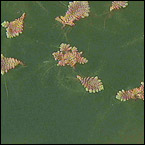 ALGAE
ALGAE 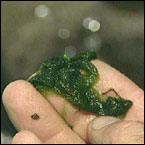 BLANKETWEED
BLANKETWEED 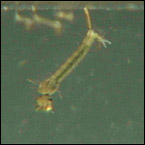 Fish
are ideal for water features because they're the best means of controlling
bugs and pests (such as mosquito larvae and water lily aphids).
Every now and then you just need to give your plants a blast with
the hose so the bugs drop into the water for the fish to eat. If
you notice mosquito larvae in your pond, stop feeding your fish
for a while. Hungry fish make the best mosquito predators.
Fish
are ideal for water features because they're the best means of controlling
bugs and pests (such as mosquito larvae and water lily aphids).
Every now and then you just need to give your plants a blast with
the hose so the bugs drop into the water for the fish to eat. If
you notice mosquito larvae in your pond, stop feeding your fish
for a while. Hungry fish make the best mosquito predators.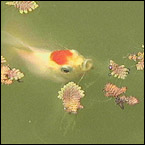 If you've got fish,
they will need some special attention coming into winter. Being
cold blooded, their metabolism rate is governed by the temperature
of the water. In the winter, they're slowing down. When the water
temperature reaches about 10 degrees — around May — it's
important to feed them a winter food. A winter fish food is lower
in protein and higher in digestibles, and is usually based on wheat
germ. The reason you feed them that through winter is that, with
the lower temperatures, their digestive system doesn't work as well
and you start to get partially digested food in the stomach. When
spring comes and the weather warms up, that starts to ferment and
they get health problems. When the water temperature gets down to
about 5 degrees, stop feeding altogether. In Auckland, that's unlikely
to happen, but in Invercargill, for example, definitely.
If you've got fish,
they will need some special attention coming into winter. Being
cold blooded, their metabolism rate is governed by the temperature
of the water. In the winter, they're slowing down. When the water
temperature reaches about 10 degrees — around May — it's
important to feed them a winter food. A winter fish food is lower
in protein and higher in digestibles, and is usually based on wheat
germ. The reason you feed them that through winter is that, with
the lower temperatures, their digestive system doesn't work as well
and you start to get partially digested food in the stomach. When
spring comes and the weather warms up, that starts to ferment and
they get health problems. When the water temperature gets down to
about 5 degrees, stop feeding altogether. In Auckland, that's unlikely
to happen, but in Invercargill, for example, definitely.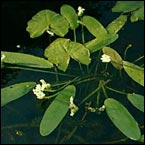 And if you've done all that and want to introduce some colour into
your pond over winter, consider the water hawthorne (Aponogeton
distachyos). This plant has oval leaves and vanilla-scented
flowers that bloom well into winter. Feed fortnightly with a water
lily fertiliser. Apart from its favourable winter-flowering appeal,
it will grow in deep water and in moving water, where water lilies
will not.
And if you've done all that and want to introduce some colour into
your pond over winter, consider the water hawthorne (Aponogeton
distachyos). This plant has oval leaves and vanilla-scented
flowers that bloom well into winter. Feed fortnightly with a water
lily fertiliser. Apart from its favourable winter-flowering appeal,
it will grow in deep water and in moving water, where water lilies
will not.